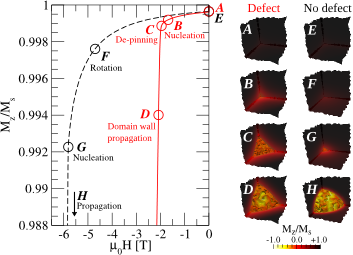Our new paper titled “Influence of defect thickness on the angular dependence of coercivity in rare-earth permanent magnets” has just been published in the journal Applied Physics Letters. It was a long time coming and the result of much collaborative effort but I am really proud that this work is finally out there. Thank you to all of my co-authors for their input, support and advice.
The work shows using micromagnetics simulations and experimental data that there is a direct connection between the coercivity in rare earth permanent magnets and the thickness of the surface defect with reduced anisotropy. The applicability of the two main theoretical models for reversal in such magnets is related to the role of such soft defects and their sizes.
 Figure: Reversal process for both the cube model with a defect shell thickness t = 1.6 nm and that with no defect shell. M − H reversal curves for both cases show distinct nucleation and pinning mechanisms.
Figure: Reversal process for both the cube model with a defect shell thickness t = 1.6 nm and that with no defect shell. M − H reversal curves for both cases show distinct nucleation and pinning mechanisms.
The journal-formatted article can be downloaded free of charge for 30 days from the publication date, and my own post-print version will be available indefinitely from this webpage.
The full citation is:
Influence of defect thickness on the angular dependence of coercivity in rare-earth permanent magnets_
Bance, S. and Oezelt, H. and Schrefl, T. and Ciuta, G. and Dempsey, N. M. and Givord, D. and Winklhofer, M. and Hrkac, G. and Zimanyi, G. and Gutfleisch, O. and Woodcock, T. G. and Shoji, T. and Yano, M. and Kato, A. and Manabe, A., Applied Physics Letters, 104, 182408 (2014), DOI:http://dx.doi.org/10.1063/1.4876451
The article is subject to copyright; Copyright 2014, American Institute of Physics.